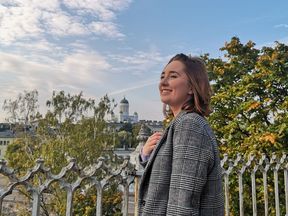Student Katarzyna Wojdalska got excited about smart materials

'One of my favorite courses I have taken at Aalto is called Solid State Materials and Phenomena. It explains thermal, electrical, dielectric, and magnetic properties of materials, but the most interesting part for me is working principles of smart materials. I learned about magneto strictive materials, piezoelectric, electroactive polymers, and shape memory alloys. Some of the terms I have heard for the first time. The course also briefly introduces topics like self-healing or thermochromic materials.
The structure of the course supported my learning considerably, because it had different ways of learning incorporated. There were lectures including a summarizing session, activating exercises in breakout rooms during the lectures, exercise sessions and our own student videos on the course topics.
The most interesting part about the course was one of the tasks. It was to record and informative video about smart materials together with a group of students. When I heard about this task, I started searching online for terms to use in my assignment. I found lots of intriguing information, for example about piezoelectrics. Piezo’s are everywhere! From our ears to lighters. The way that they work is when you apply a force on them, they give an electric signal in return. Incredible! After I did some more research, I found another topic that interested me even more: magneto strictive materials. They are used for energy harvesting purposes.
I had never heard about such materials before and I did look them up on the internet. Also, our lecturer Kirsi Yliniemi, taught us the terms during class. She explained their working purpose well enough to spark my interest. What my team members and I discovered while preparing the video went beyond our wildest expectations. We learned for example, that in a research conducted in China they used a 3D printed bone that could possibly charge an intelligent wristband of the user upon walking. How insane! This assignment was the most exciting part of the course, I learned a lot of new things!
In this course, there were different kinds of exercises you had to do to pass the course. We had to submit exercises solved by ourselves weekly. We also needed to do the following tasks in a group: record a video, watch a recording of another team and write a review of it. We also had lectures consisting of two-hour long lectures and three-hour long session for tasks. During the task session we had plenty of time to go through the questions for our homework and answer all of them. Our lecturer Kirsi Yliniemi, showed tips for solving the tasks. After this we got to do the tasks ourselves, and she advised anyone who got stuck in the problems. The written exercises consisted usually of three assignments from which two were calculations and a single-choice quiz. For each of the chosen answers in the quiz, we were supposed to write down our reasoning.
I took the course from September 2020 onwards, so during the Covid19-pandemic. Therefore, we had to use a platform called Zoom. Each session began with Yliniemi showing us a short presentation with the tips for each exercise and then we could either stay in the main room or join a breakout room.
I worked on the exercises with a classmate in a breakout room. Each time we had some doubts or felt we need some support; we raised our online hands to invite Yliniemi to help us. After the class ended, I usually did the homework on the same day as the exercise session took place. The other big tasks for the course, the video, was due at the beginning of October. For the video production, my team members and I had to meet a few times online to plan the execution and share insights from reading scientific articles. We met once at the campus in Otaniemi to record the video.
We also had an exam at the end of the course. Because we had done so much work during the course itself, I did not feel that the exam at the end was very difficult. It was challenging, but it was easily achievable to write it well enough and get a satisfying grade. Of course, only after putting some time in learning during the whole course period. The exam took place online and there was a possibility to write it either in a group or alone. I wrote the assessment with the same classmate I had to solved the exercises with and we succeed to be evaluated very high. The examination lasted 4 hours and 30 minutes, from which last 30 minutes were intended to create a PDF file and then upload it into the school platform. There were 5 questions. '

Lecturer Kirsi Yliniemi, what do you think makes a great learning experience?
'We teachers at the School of Chemical Engineering can often be very proud of our students, their activity and innovativeness; this happens especially when our students get excited about the topics, and want to learn more. For this to happen it is extremely beneficial that students take an active role also in their learning process, i.e. ask questions during teaching sessions and “own their learning” by finding more information independently about teaching topics. Such a positive and enthusiastic approach towards learning leads to a deeper understanding – and such an attitude is naturally extremely beneficial later on in working life too.'






